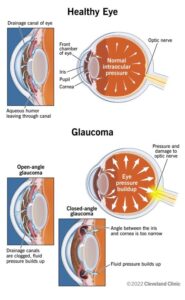What is glaucoma?
Glaucoma is a group of eye diseases that can cause vision loss and blindness by damaging a nerve in the back of your eye called the optic nerve.
The symptoms can start so slowly that you may not notice them. The only way to find out if you have glaucoma is to get a comprehensive dilated eye exam.
There’s no cure for glaucoma, but early treatment can often stop further damage and protect your vision.

What are the types of glaucoma?
There are many different types of glaucoma, but the most common type in the is open-angle glaucoma Other types are less common, like angle-closure glaucoma , congenital glaucoma, secondary glaucoma, etc .

What are the symptoms of glaucoma?
People want to know what the early warning symptoms of glaucoma are. The problem is that for some types of glaucoma, there aren’t any early warning symptoms, and changes to vision can happen gradually, so the symptoms are easy to miss. Because many people with open-angle glaucoma don’t have any noticeable symptoms, it’s very important to have routine eye exams to detect this disease in its earlier stages. Glaucoma damage is irreversible, so you need early detection and treatment to prevent blindness.
Closed-angle glaucoma has more severe symptoms that tend to come on suddenly.
With any type, you may experience:
- Eye pain or pressure.
- Rainbow-colored halos around lights.
- Low vision, blurred vision, narrowed vision (tunnel vision) or blind spots.
- Nausea and vomiting.
- Red eyes.
Am I at risk for glaucoma?
Glaucoma can affect anyone, but the risk increases with age. People who are Black and Hispanic are much more likely to get glaucoma than other ethnic groups, and they tend to develop the disease earlier in life. Asian and Inuit populations are also more susceptible to a specific form of glaucoma known as angle-closure glaucoma or closed-angle glaucoma.
People with diabetes are twice as likely to get glaucoma. Other risk factors include:
Family history of glaucoma.
Farsightedness or hyperopia (for closed-angle glaucoma).
High blood pressure (hypertension and very low blood pressure (hypotension)
Long-term use of corticosteroids.
Nearsightedness or myopia (for open-angle glaucoma).
Previous eye injury or surgery.

When to get help right away
- Blurred or low vision.
- Halos, eye floaters or flashers.
- Sudden, severe eye pain or headaches.
- Sensitivity to light.
- Vision loss.
If you have any of these symptoms, go to your doctor or an emergency room immediately.

What causes glaucoma?
Glaucoma can occur without any cause, but many factors can affect it. The most important of these factors is intraocular eye pressure. Your eyes produce a fluid called aqueous humor that nourishes them. This liquid flows through your pupil to the front of your eye. In a healthy eye, the fluid leaves through the drainage canals located between your iris and cornea.
With glaucoma, the resistance increases in your drainage canals. The fluid has nowhere to go, so it builds up in your eye. This excess fluid puts pressure on your eye. Eventually, this elevated eye pressure can damage your optic nerve and lead to glaucoma.
How will my eye doctor check for glaucoma?
Eye doctors can check for glaucoma as part of a comprehensive dilated eye exam. The exam is simple and painless — your doctor will give you some eye drops to dilate (widen) your pupil and then check your eyes for glaucoma and other eye problems. The exam includes a visual field test to check your side vision.
Did you know?
- Glaucoma can happen in 1 eye or both eyes
- Some people with high eye pressure don’t get glaucoma — and there’s a type of glaucoma that happens in people with normal eye pressure
- Normal eye pressure varies by person — what’s normal for 1 person could be high for another

How is glaucoma diagnosed?
It’s possible to have glaucoma and not know it. Regular eye exams are important to catch glaucoma or other eye problems. Eye exams can assess optic health and vision loss.
To check for glaucoma, an eye doctor may do one or more of these painless tests:
Dilated eye exam to widen pupils and view your optic nerve at the back of your eyes.
Gonioscopy to examine the angle where your iris and cornea meet.
Optical coherence tomography (OCT) to look for changes in your optic nerve that may indicate glaucoma.
Ocular pressure test (tonometry) to measure eye pressure.
Pachymetry to measure corneal thickness.
Slit-lamp exam to examine the inside of your eye with a special microscope called a slit lamp.
Visual acuity test (eye charts) to check for vision loss.
Visual field test (perimetry) to check for changes in peripheral vision (your ability to see things off to the side).
What’s the treatment for glaucoma?
Doctors use different types of treatment for glaucoma, including medicines (usually eye drops), laser treatment, and surgery.
If you have glaucoma, it’s important to start treatment right away. Treatment won’t undo any damage to your vision, but it can stop it from getting worse.
Talk over your options with your doctor. While glaucoma is a serious disease, treatment works well. Remember these tips:
- If your doctor prescribes medicine, be sure to take it every day
- Tell your doctor if your treatment causes side effects
- See your doctor for regular check-ups
- If you’re having trouble with everyday activities because of your vision loss, ask your doctor about vision rehabilitation services or devices that could help
- Encourage family members to get checked for glaucoma, since it can run in families

